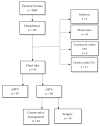Risk Factors for Retained Hemothorax after Trauma: A 10-Years Monocentric Experience from First Level Trauma Center in Italy
- PMID: 36294709
- PMCID: PMC9605043
- DOI: 10.3390/jpm12101570
Risk Factors for Retained Hemothorax after Trauma: A 10-Years Monocentric Experience from First Level Trauma Center in Italy
Abstract
Thoracic trauma occurs in 20-25% of all trauma patients worldwide and represents the third cause of trauma-related mortality. Retained hemothorax (RH) is defined as a residual hematic pleural effusion larger than 500 mL after 72 h of treatment with a thoracic tube. The aim of this study is to investigate risk factors for the development of RH in thoracic trauma and predictors of surgery. A retrospective, observational, monocentric study was conducted in a Trauma Hub Hospital in Milan, recording thoracic trauma from January 2011 to December 2020. Pre-hospital peripheric oxygen saturation (SpO2) was significantly lower in the RH group (94% vs. 97%, p = 0.018). Multivariable logistic regression analysis identified, as independent predictors of RH, sternum fracture (OR 7.96, 95% CI 1.16-54.79; p = 0.035), pre-admission desaturation (OR 0.96; 95% CI 0.77-0.96; p = 0.009) and the number of thoracic tube maintenance days (OR 1.22; 95% CI 1.09-1.37; p = 0.0005). The number of tubes placed and the 1° rib fracture were both significantly associated with the necessity of surgical treatment of RH (2 vs. 1, p = 0.004; 40% vs. 0%; p = 0.001). The risk of developing an RH in thoracic trauma should not be underestimated. Variables related to RH must be taken into account in order to schedule a proper follow-up after trauma.
Keywords: acute care surgery; hemothorax; retained hemothorax; thoracic surgery; thoracic trauma; trauma.
Conflict of interest statement
The authors declare no conflict of interest.
Figures
References
-
- Lecky F.E., Bouamra O., Woodford M., Alexandrescu R., O’Brien S.J. Damage Control Management in the Polytrauma Patient. Springer New York; New York, NY, USA: 2010. Epidemiology of Polytrauma; pp. 13–24. - DOI
-
- Kulvatunyou N., Bauman Z.M., Edine S.B.Z., De Moya M., Krause C., Mukherjee K., Gries L., Tang A.L., Joseph B., Rhee P. The small (14 Fr) percutaneous catheter (P-CAT) versus large (28–32 Fr) open chest tube for traumatic hemothorax: A multicenter randomized clinical trial. J. Trauma Acute Care Surg. 2021;91:809–813. doi: 10.1097/TA.0000000000003180. - DOI - PubMed
LinkOut - more resources
Full Text Sources




